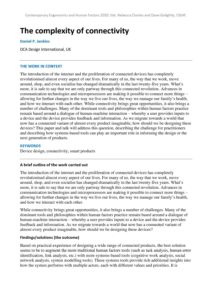| Document | Author Daniel P. Jenkins |
| Abstract The introduction of the internet and the proliferation of connected devices has completely revolutionised almost every aspect of our lives. For many of us, the way that we work, move around, shop, and even socialise has changed dramatically in the last twenty-five years. What’s more, it is safe to say that we are only partway through this connected revolution. Advances in communication technologies and microprocessors are making it possible to connect more things – allowing for further changes in the way we live our lives, the way we manage our family’s health, and how we interact with each other. While connectivity brings great opportunities, it also brings a number of challenges. Many of the dominant tools and philosophies within human factors practice remain based around a dialogue of human-machine interaction – whereby a user provides inputs to a device and the device provides feedback and information. As we migrate towards a world that now has a connected variant of almost every product imaginable, how should we be designing these devices? This paper and talk will address this question, describing the challenge for practitioners and describing how systems-based tools can play an important role in informing the design or the next generation of products. |

